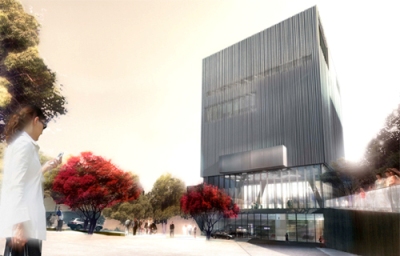Oct 19 2009
Redefining the traditional theater -- from top to bottom
During the AT&T Performing Arts Center's Dee and Charles Wyly Theatre's grand opening this week, audiences are discovering a 575-seat, "multi-form" theater that gives one of the country's most innovative performing arts companies an unprecedented reconfiguration of both house and stage.
 AT&T Performing Arts Center's Dee and Charles Wyly Theatre
AT&T Performing Arts Center's Dee and Charles Wyly Theatre
Unlike a typical theater, the Wyly positions back-of-house and front-of-house facilities above and beneath the auditorium instead of encircling it. Designed by REX/OMA, Joshua Prince-Ramus (Partner in Charge) and Rem Koolhaas, the new home of the Dallas Theater Center is thereby transformed into one large fly tower that provides an infinite variety of stage configurations, and liberates the performance chamber's perimeter to allow fantasy and reality to mix when and where desired. The Wyly Theatre's design was begun in 2004 by OMA New York, a firm owned equally by Prince-Ramus and Koolhaas. In 2006, Prince-Ramus bought Koolhaas out of the company and renamed the existing entity REX.
Prince-Ramus, who will give a lecture in the Wyly Theatre, October 16 at 2 p.m., comments, "The Wyly is a 'theater machine' that grants freedom to determine the entire artistic experience, from audience arrival to performance configuration to departure."
The Dallas Theater Center's previous accommodation, a makeshift residence located in a galvanized metal shed, liberated its users from the limitations imposed by a fixed-stage configuration and the need to avoid harming expensive interior finishes. The Wyly Theatre's unprecedented "stacked" design meets two distinct challenges -- it retains and refines the same freedoms that made the DTC's original building a successful theater space and creates a new theatrical structure that combines flexibility with affordability.
The theater can be altered into a wide array of configurations -- including proscenium, thrust and flat floor -- empowering directors and scenic designers to choose the stage-audience configuration that fulfills their artistic desires, or to invent one of their own. Directors can incorporate the Dallas skyline and streetscape into performances at will, as the auditorium is enclosed by an acoustic glass facade with optional black-out blinds and panels that can be opened to allow patrons or performers to enter the auditorium directly from outside. The performance chamber is intentionally made of materials that are not precious to encourage alterations; the stage and auditorium surfaces can be cut, drilled, painted, welded, sawed, nailed, glued and stitched at limited cost.
On a Friday night, patrons can share Lear's sorrow in a dark and quiet theater. Then Saturday evening, against the dramatic backdrop of the Dallas cityscape, the audience can join Vladimir and Estragon in their vigil for Godot, in an auditorium now stripped of its comforting cocoon.
Source: http://www.rex-ny.com/